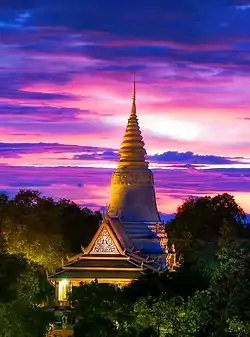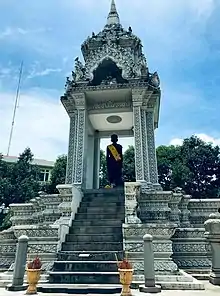Wat Phnom
Wat Phnom (Khmer: វត្តភ្នំ; "Mountain Pagoda") is a Buddhist temple (Wat) is a pagoda that symbolizes the name of Phnom Penh, a historical site in the record of Khmer national identity. Wat Phnom Doun Penh has a total height of 46 meters equal to the height of feet (150ft)[1] This pagoda is named after the grandmother "Doun Penh" who has the story of the discovery of the four statues:
- Vishnu statue
- Buddha Statue
- Indra Statue
- Fat Buddha Statue (Chinese: 布袋) (English: Budai) It is this connection that led to the construction of the Chinese hermitage there.[2]
| Wat Phnom | |
|---|---|
វត្តភ្នំ | |
 View of Wat Phnom | |
| Religion | |
| Affiliation | Theravada Buddhism |
| Status | Wat Phnom historical park |
| Location | |
| Location | Phnom Penh, Doun Penh District |
| Country | Cambodia |
| Geographic coordinates | 11°34′34″N 104°55′23″E |
| Architecture | |
| Founder | Lady Penh |
| Completed | 1373 |
History

In 1372, there was an old lady named "Doun Penh" who was very wealthy and lived near the bank of the confluence of the four rivers. Doun Penh's house was built on a hill east of a small mountain. One day, when it was raining, Doun Penh went down to the port to take a bath. As if there were something in the hole of the Koki tree, Daun Penh took a piece of wood to scrape and clean the mud, he found in the hole of the tree Koki, there are four statues made of bronze and brass and one made of marble. In that statue, He stands with one hand holding a staff and a chain in the other, He holds a snail and a lotus flower in the form of Vishnu. Doun Penh went to tell the villagers to help take the Koki tree and receive the four treasures of the statues to be worshiped. Later, "Doun Penh" assigned the villagers to build an hermitage on the top of this small mountain to place the four statues as a place of worship. She also invited monks to pray for the statue. All four of them will be remembered by the monks at the naming of the hermitage "Wat Phnom" which we know well to this day. [3]
Wat Phnom Doun Penh during the reign of King Ponhea Yat

After King Ponhea Yat, the emperor, lived in the Tuol Ban San palace for nine years, there was severe flooding in that area, during which time the capital was flooded deep in 1396 AD. When the water receded that year, he led the governer to build a new palace in Russey Keo village in the area of (Wat Phnom) today. He ordered Chao Ponhea Techo, the governor of Samrong Tong district, to mobilize the people to fill the palace. The place where Chao Ponhea Techo asked the people to dig the land is very large and deep, which is why it is called Boeung Techo, which is now located in Central Market, Phnom Penh. After a year of flooding, King Ponhea Yat decided to move the capital from Tuol Basan, Kampong Cham province to the confluence of the Tonle Sap River in 1397 AD. After the completion of the palace, King Ponhea Yat ordered the construction of a hermitage hut on the top of the mountain near the temple of Wat Phnom, the hermitage of the district chief, which Cambodians today call Neak Ta Preah Chao and Wat Phnom called "Wat Phnom Doun Penh" "Which marks the name of Grandma" Doun Penh ". After completing the construction of palaces and cities, he named the city "Chaktomuk Sakal Kampuchea, Thibdey Udiya Mohanakor" in 1416 AD, later changed its name to Phnom Penh today. Finally, King Ponhea Yat announced the change of reign of the "Chaktomuk period" in 1431, and he died in 1434, leaving a large stupa on the historical site of Wat Phnom to this day.[4]
Architecture

The sanctuary itself was rebuilt several times in the 19th century and again in 1926. The interior has a central altar complex with a large bronze seated Buddha surrounded by other statues, flowers, candles and items of devotion and worship. The walls are covered with murals, especially of Jataka stories of the Buddha's earlier reincarnations before his enlightenment. There are also murals depicting stories from the Reamker, the Khmer version of the Ramayana. The newer murals in the bottom tiers are somewhat balanced, traditional and modern.
The southwest corner of the temple and stupa, is a small shrine dedicated to Lady Penh. The front is often crowded with the faithful bringing their prayers and food offerings to the woman deemed responsible for the founding of the wat.
 The main stupa on Wat Phnom
The main stupa on Wat Phnom Main pagoda
Main pagoda Main stairway leading to the Pagoda
Main stairway leading to the Pagoda Statue of King Sisowath
Statue of King Sisowath Paintings inside the temple
Paintings inside the temple.jpg.webp) Buddhist shrine inside the pagoda
Buddhist shrine inside the pagoda
Culture References
Wat Phnom appeared on the Travel Channel documentary, 1,000 Places to See Before You Die. It also served as the Pit Stop for the fourth leg of The Amazing Race 15.[5]
See also
References
- "Wat Phnom Cambodia". Peakbager.com database. Retrieved 1 November 2004.
- ក្រុមជុំនំទំនៀមទំលាប់ខ្មែរ ពុទ្ធសនបណ្ឌិត្យកម្ពុជា (22 May 2006). Prajuṃ rẏaṅ breṅ khmaer, Volume 5. Buddhasāsana Paṇḍity, 1963 the University of Michigan.
- Cambodia. Krasuaṅ Ghosanākār nẏṅ Vappadharm (1990). Prajum rẏan breṅ Khmaer, Volume 5. Buddha Sāsanapaṇdity, Original from University of California, Berkeley.
- Hoc Dy Khing. Aperçu général sur la littérature khmère. Paris ; Montréral, Qc : L'Harmattan, ©1997. p. 205. ISBN 1179208816
- "'Amazing Race': Episode 3 recap". Digital Spy. December 10, 2009. Retrieved December 31, 2019.
External links
- 360° aerial panorama of Wat Phnom
 Media related to Wat Phnom at Wikimedia Commons
Media related to Wat Phnom at Wikimedia Commons